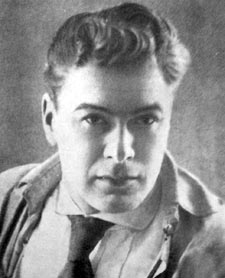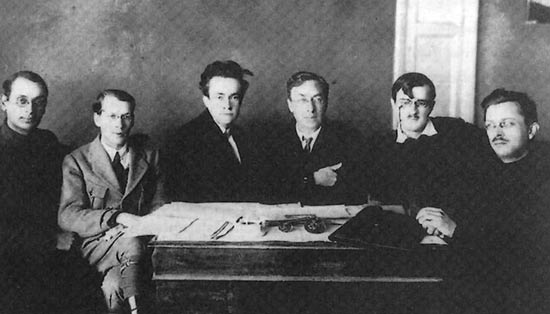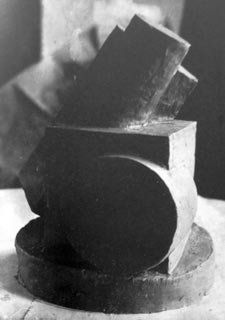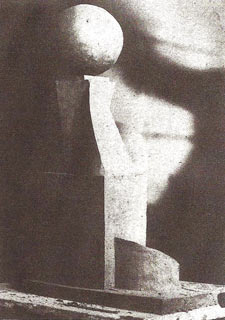Alexei Vasilevich Babichev 1887 - 1963
Biography
Like many of the artists who lived and worked during the revolutionary period information on the life of Alexei Babichev is extremely sparse. This biography is an assemblage of the most relevant aspects of his life in terms of this collection. Only one detailed work about his life has ever been published, this was by D Sarabyanov in 1974.
 Sculptor - Babichev The author is one of Russia's greatest art historians, but even he has to admit that very little is known about this versatile and talented artist.
Sculptor - Babichev The author is one of Russia's greatest art historians, but even he has to admit that very little is known about this versatile and talented artist.
More so than that of Lavinskii, his name is published in the many surviving minutes of the steering committee meetings of the INKhUK and the Vkhutemas.
From the beginning of his artistic career it is evident that he enjoyed theoretical thinking, but it is difficult to comprehend the vast gap between his actual influence in the events of the period and what meagre quantity of work that has been written about him. He was an excellent and talented teacher who devoted much energy to the Vkhutemas. He was also a profound theorist who was in the midst of the struggle of artistic ideas which were unfolding in the early revolutionary period.  During the early 1920s he was heavily engaged in the organisational work of both the INKhUK and the Vkhutemas. INKhUK members The period of his heavily productive work was relatively short lived, and later his work became progressively less frenetic. Why and how this happened is still a mystery, but during his early years at the Vkhutemas he was one of the principal movers behind the development of the artistic direction at the school.
During the early 1920s he was heavily engaged in the organisational work of both the INKhUK and the Vkhutemas. INKhUK members The period of his heavily productive work was relatively short lived, and later his work became progressively less frenetic. Why and how this happened is still a mystery, but during his early years at the Vkhutemas he was one of the principal movers behind the development of the artistic direction at the school.
Aleksei Babichev was born in 1887 to a wealthy Moscow family. He graduated from high school in 1906 and enrolled in Moscow University where he studied mathematics, and at the same time took painting lessons. Here he began to follow the political events preceding the revolution. During the year of 1910 he witnessed public executions of revolutionaries and was subsequently moved to become involved in their activities. He graduated from university in 1912, and travelled to Europe with Vera Mukhina. During 1913 to 1914 he studied under A. Bourdelle for a brief period in Paris.
 Whilst in Europe he was drawn to the work of the Italian futurists and translated numerous articles and treatises for himself. He translated a work by Umberto Boccioni from the catalog of the Paris Exhibition and several articles about contemporary sculptors. It is evident from his personal notes of the period he was developing his talent as an artist theoretician and was particularly interested in the work of Jacques Lipchitz. His talent in the theoretical domain is really shown in his work at the INKHUK. The INKhUK was formed in 1920. Its main task was to create a science which would explore the main categories of art as a whole, its individual types and the principals of interaction of these types. It was formed in order to subject the arts to scientific discipline. Wassily Kandinsky was the first chairman of the INKhUK, but his program was judged too subjective and theoretical and he was obliged to leave the institute. In subsequent years the post of chairman was held by Aleksandr Rodchenko, Osip Brik, and Boris Arvatov, from which one can judge the type of objective direction which would prevail at the institute.
Whilst in Europe he was drawn to the work of the Italian futurists and translated numerous articles and treatises for himself. He translated a work by Umberto Boccioni from the catalog of the Paris Exhibition and several articles about contemporary sculptors. It is evident from his personal notes of the period he was developing his talent as an artist theoretician and was particularly interested in the work of Jacques Lipchitz. His talent in the theoretical domain is really shown in his work at the INKHUK. The INKhUK was formed in 1920. Its main task was to create a science which would explore the main categories of art as a whole, its individual types and the principals of interaction of these types. It was formed in order to subject the arts to scientific discipline. Wassily Kandinsky was the first chairman of the INKhUK, but his program was judged too subjective and theoretical and he was obliged to leave the institute. In subsequent years the post of chairman was held by Aleksandr Rodchenko, Osip Brik, and Boris Arvatov, from which one can judge the type of objective direction which would prevail at the institute.
In the vacuum left after Kandinsky's departure Babichev prepared the artistic curriculum for the institute in 1921. From 1912 when he graduated, with the exception of his period in Europe, Babichev taught throughout his whole life. He began teaching at the Gymnasium and then at his own private studio. In 1918 he was elected professor at the First State Free Art Studios, and in the following years his name is frequently cited alongside , Aleksandr Rodchenko, Vladimir Tatlin, Vera Mukhina, Kazimir Malevitch, Boris Korolev, Georgii Yakulov, Osip Brik, etc. He was extremely influential in the transformation of the State Free Art Studios into the Vkhutemas and naturaly became a professor of sculpture there. The culmination of his pedagogical principals were realised at the Vkhutemas. Here he taught sculpture along with A. Lavinskii, and B Korolev. In addition he managed the workers facility of arts as well as the Monolith organisation.A list of Babichev’s artistic achievements would be the envy of any professional artist, and yet today details of his life and work are almost unknown by the vast majority of art scholars and experts. Of his work, Sarabyanov comments: "If the 'architectons' of Malevitch and the 'prouns' of Lissitsky are dominated by the spirit of architecture, then Babichev’s abstract constructions reign supreme in design". Babichev died in May 1963. Most of his archive has disappeared, but some was purchased by George Costakis and is what is left is housed at the Museum of Modern Art at Thesalonica. Babichev’s work can be divided into 3 periods. The work he did in the 1910’s, the second from the Paris experience to the mid 1920’s, and the last from the mid 20’s to the end of his life.
 Sculpture by Babichev Of these the most intensive is that of the 1920's, though until now virtually none of his work has been seen publicly. This collection is the largest single assembly of his work from the 1920s and clearly demonstrates his outstanding application of the principals of volume and design in the art of sculpture.
Sculpture by Babichev Of these the most intensive is that of the 1920's, though until now virtually none of his work has been seen publicly. This collection is the largest single assembly of his work from the 1920s and clearly demonstrates his outstanding application of the principals of volume and design in the art of sculpture.
